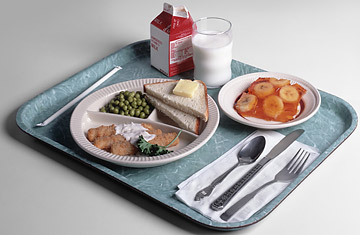Jail Life: Deputies discuss issues from food to pop culture to repeat offenders
October 4th, 2015 Posted in Logan NewsEditor’s Note: Journalism students in USU’s public affairs reporting class recently toured the Cache County Jail on West 200 South. Four of them report on some of the issues confronting inmates and corrections officers.
Inmate mental health a continuing concern at county jail
By Rebecca Wheatley
LOGAN — If Deputy Chris Toone could change anything about the Cache County Jail, it would be how they handle the mental health of inmates.

Cache County Jail (Amanda Wray photo)
Toone said one of his biggest concerns is that when inmates with mental illnesses come into the jail, deputies aren’t able to give them the help they need.
Toone said many of the inmates should be admitted into hospitals to get the medication they need, but have to wait in the jail because there aren’t enough hospital beds for them.
“I can’t help them,” Toone said. “A mentally ill person doesn’t need to be locked up in here by themselves where we can’t give them the help they need.”
The only mental health services offered to inmates are evaluations with Bear River Mental Health, but Toone said Bear River sends personnel only about once a week to meet with inmates.
Deputy Danny Hulse said he is also concerned with the mental health services offered in the jail. “When these people come in with mental illnesses, it’s obvious that they have a problem,” he said.
Hulse said these inmates usually need medication, but that is something the jail can’t provide. This is why it’s so important for the inmates to get into a hospital where they can get the care they need, he said.
“A lot of times people aren’t getting the medications they need, so we end up seeing them in here again as repeat offenders,” Hulse said. “It’s a problem because their medication can often keep them out of trouble.”
TP
~ ~ ~ ~ ~
Jail food ‘doesn’t look good,’ deputy says, but some inmates gain weight
By Melanie Fenstermaker
LOGAN — When Deputy Chris Toone asked an inmate of the Cache County Jail what his worst experience in jail had been, his response was, “Dinner.”
Although the three daily meals inmates are served in jail give them a sufficient amount of nutrients and calories, Toone said, the food isn’t always appetizing.
“They don’t look good,” Deputy Danny Hulse added. “They really don’t taste good, either.”

File photo
Unless they have dietary restrictions or are pregnant, inmates are served approximately 2,500 calories per day, he said. The meals vary, and typically include spaghetti, chicken and bologna sandwiches, lasagna, beans, meat and rice. Breakfasts often include pancakes, hash browns and biscuits, the deputy said.
“Obviously, getting food here isn’t like going in and getting food at a local restaurant,” said Lt. Doyle Peck, a jail commander. Spending $8 per meal to provide restaurant-quality food would “cost taxpayers millions,” he said.
The cost of feeding the inmates fluctuates depending on the number of inmates, Peck said, so he had no estimated cost of each meal.
Peck said inmates who come from difficult financial situations are happy with the food. “The odd thing is that the food they get here is often better than what they get on the outside, because of the circumstances they come from,” he said. “I’ve seen people gain weight here.”
Peck said he has often eaten jail food. “It really isn’t that bad,” he said.
The meals are fairly appetizing when fresh vegetables from the jail’s garden are added, he said. The inmate-tended garden near the jail grows tomatoes, corn, squash, beans and other vegetables yearly to supplement the jail diet.
“Special trays” are served on holidays, Peck said. A Thanksgiving dinner, for example, might include mashed potatoes, stuffing, turkey and a dessert.
Inmates who are unsatisfied with the meals can buy food through the jail’s commissary — including snacks, ramen, sodas, paper goods, hygiene products and other items.
Some inmates earn money for commissary items by working in the jail’s kitchen, laundry room, library and other facilities for between 50 cents and 75 cents per hour, Hulse said. He said they can also buy the goods with personal money or money given to them by their family.
Peck doesn’t see a problem with the food served in the jail. “Some deputies like to joke about it, but the food isn’t that bad,” he said. “Is it what they get at Firehouse [Pizza]? No, but it has all the calories and nutrients they need.”
TP
~ ~ ~ ~ ~
Real-life jail: TV sensationalizes life behind bars
By Mekenna Malan
LOGAN — Since the premiere of the Netflix original series, “Orange Is the New Black,” in 2013, outsider interpretations of prisons and jails have been warped by pop culture. The TV series has received praise for its writing and plot, as well as its portrayal of women.
After the release of the show’s third season in June, critics complained about its increasing portrayal of drug use, nudity, violence and lesbian sex.
 But real jail life is not so melodramatic, say Cache County Sheriff’s Deputies Danny Hulse and Chris Toone. The Cache County Jail — and other jails and prisons around the country — don’t quite operate the same as they are portrayed on television, they say.
But real jail life is not so melodramatic, say Cache County Sheriff’s Deputies Danny Hulse and Chris Toone. The Cache County Jail — and other jails and prisons around the country — don’t quite operate the same as they are portrayed on television, they say.
“The thing I have against shows like that is they only show you the bad,” Toone said. “They show you guys in lockdown and people fighting and in trouble.
“I’m a correctional officer, so I think what I’m doing here is right and good. But the television shows don’t show you that,” he added.
“Orange Is the New Black” has been given a mature rating for its sexual themes. But at the Cache County Jail, male and female inmates are always kept separate to discourage sexual activity. Men and women do not work together, are housed in separate blocks and are allowed virtually no interaction with the opposite gender, the deputies say.
“Inmates are never mixed,” Toone said. “It’s a safety issue. They could pass things back and forth, [and] other problems could arise. So we don’t even allow different blocks out [for exercise] at the same time.”
The growing number of gay and transgender individuals in society does pose some issues at the jail. Pop culture makes it seem like jails and prisons are hotspots for sexual activity of all kinds, but not at the Cache County Jail.
“It does pose a housing problem for us,” Hulse said. “A lot of times, though, if someone is attracted to the same sex, they will let us know. They will ask not to be placed with those individuals because they don’t trust themselves around members of the same sex and don’t want to cause a problem.”
Although the rules may change, for now, the jail operates strictly along biological lines.
“Everyone who decides to stay for any period of time is strip-searched before they are assigned to a [cell] block,” Hulse said. “So despite what they say their gender is, we have a pretty good idea of who, biologically, we are dealing with.”
Sexual encounters in general are not as common as they are portrayed on TV, Toone said. He suspects any sexual encounters that do occur within jail blocks are rare and consensual.
“I’d like to tell you that we never have any sexual encounters in here, but I’m sure that’s not true,” he said. “Even with consent, it’s against the rules. It couldn’t happen very often because of how closely the inmates are watched.”
Hulse said he has only seen a problem once in the three years he has worked at the Cache County Jail.
And while “Orange Is the New Black” portrays jails and prisons as places of violence, Toone says the jail deputies will go months at a time without having to sort out a fight. He believes that, for the most part, a jail block is not as much of a high-contention, sexually-driven environment as television may make it seem.
“It’s interesting because you walk through the blocks and that’s what the inmates are watching,” Hulse said. “They are watching television shows about jail from jail, and it’s complete BS.”
TP
~ ~ ~ ~ ~
Too few jail inmates take advantage of programs to avoid recidivism
By Jordan Floyd
LOGAN — Inmates in the Cache County Jail have access to numerous self-improvement and rehabilitative programs, but Deputy Danny Hulse believes not enough inmates are taking advantage of them.
“The opportunity is there for them,” Hulse said. “They just have to take it.”
The Cache County Jail offers multiple programs aimed at preparing inmates for life after release, ranging from Alcoholics Anonymous and community employment, to tending the jail vegetable garden in summer, and classes where inmates can earn a GED certificate.

Photo illustration
“People will say there is nothing here for the inmates,” said Deputy Chris Toone. “But when you take a look at the long list of programs, you see a lot of the inmates aren’t involved in any of them.”
“Recidivism,” generally defined as the rate at which inmates reoffend upon release, is a large problem nationwide that many blame on the corrections system. In 2014, the federal Bureau of Justice Statistics reported, “Among state prisoners released in 30 states in 2005, about 2/3 (67.8%) of released prisoners were arrested for a new crime within three years, and 3/4 (76.6%) were arrested within five years.”
National spending to bolster programming in the corrections system has increased from $30 billion to about $52 billion, according to a Pew Center study. Still, recidivism remains high. The Pew study found that in Utah alone, over half of the inmates released will reoffend within within three years of release.
In Cache County, the recidivism rate is only 15 percent, but the number of inmates returning is still sizeable, according to Hulse.
“A lot of people return,” Hulse said. “We get a lot of repeat drug offenses and warrants.”
In 2012, the Cache County Sheriff’s Office reported 320 arrests for possession of a controlled substance or drug paraphernalia, and another 774 arrests on failure-to-appear warrants.
“I know a guy who was booked here 12 times because he wouldn’t go to court,” Hulse said. “Some people are too stupid to just go to court.”
Roughly half of the Cache County Sheriff’s budget goes toward jail operations and programming. Hulse believes the problem with recidivism isn’t a matter of the correctional system, but rather lies within the choices of the individual inmates.
“All of the inmates have the option try to better themselves,” he said. “A lot of them are good people that have made bad decisions — but they can choose to turn their life around.”
TP
Tags: Cache County Jail, Cache County Sheriff, Chris Toone, Danny Hulse, Doyle Peck, mental health, Orange Is the New Black, recidivism, sensationalism

Sorry, comments for this entry are closed at this time.